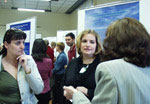|
 back back

|
|
Gregory R. Crane
Professor of Classics, Tufts University
Medford MA
Editor-in-Chief, Perseus Project, 1988-
Co-Director, Perseus Project, 1986-1988
Field
Greek and Latin Literature and Civilization
Computer Applications in Research and Education
Professor Paolo Galluzzi
Prof Galluzzi is the Director of the Istituto e Museo Nazionale di Storia della Scienza in Florence. He is President of the Commissione Vinciana, of the Fondazione
Scienza e Tecnica of the Fondazione Rinascimento Digitale.
He has been Visiting Professor at several institutions (Department of the
History of Science at Harvard University. Princeton University, University of California, Los Angeles, University of Hamburg, Centre Koyré, at the Ecole des Haute Etudes, Paris and New York University, N.Y. as well as in many other universities and research centres both in Italy and abroad).
He was President of the International Union for the History and Philosophy of
Science, History of Science Division.
Since 1999 he has acted as Chairman of the Advisory Board for the Max Planck Institut für Wissenschaftsgeschichte, Berlin. In 2001 he was nominated Member of the Advisory Board of the Deutsches Museum, Münich. He is a member of the Royal Academy of Science, Stockholm and of the American Philosophical Society of Philadelphia.
In 2003 he was awarded by the President of the Italian Republic the Gold Medal for his outstanding contribution to the promotion of scientific heritage and to research in the humanities. In 2005 he was decorated as Grand Officer of the Order of Merit of the Italian Republic.
His numerous publications focus on the activity of the scientists and engineers of the Renaissance (Leonardo and thereabouts), on several aspects of science during the Renaissance and the Scientific Revolution, on scientific terminology, on the activities of Galileo and his school, on the history of the European scientific academies and on the birth and history of the historiography of science. He has devoted studies to the history of scientific instrumentation, of scientific museums, and of scientific heritage.
During the last 15 years, he has been involved in the preparation of multimedia applications, conceived as tools to promote research, to improve access to important sources for the history of science and techniques and to facilitate the public understanding of crucial issues of the history of science and technology and of cultural and scientific heritage.
|
|






|







